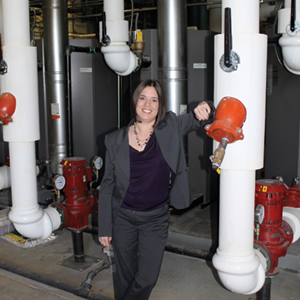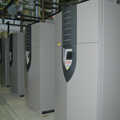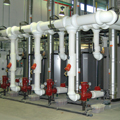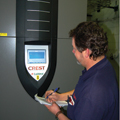Walgreens’ HQ in suburban Chicago realized major savings after installing four condensing boilers in one of its mechanical rooms on the expansive corporate campus. Pictured here is Emcor Team Mechanical VP of Engineering Cindy Stelzer, P.E. Her company was the MEP engineering firm of record on the project.

There’s something to be said for networking.
Walgreens Manager of Building Operations, Bill Lewis is also treasurer of the Northern Illinois chapter of the International Facility Management Association. On one of the trade association’s facility tours to Techny Towers Conference and Retreat Center in Techny, Ill., Lewis was impressed by the size and efficiency of the newly installed condensing boilers.
“Techny showed substantial utility bill savings by replacing their old boilers,” he says.
Back at Walgreens corporate headquarters in the northern Chicago suburb of Deerfield, Ill., Lewis tasked Tim Spulak (HVACR foreman) and Sam Jones (HVAC technician) with studying the feasibility of replacing three old, inefficient low steam-pressure boilers with this new technology. The boilers heated the central plant they sat in and four five-story buildings spanning 364,000 sq. ft. of space on the expansive Deerfield corporate campus the drugstore giant calls home.

“We had three giant locomotive-looking boilers sitting there,” Lewis states.
Lewis got the ball rolling by submitting a capital request to replace the boilers in keeping with the company’s goal of reducing energy usage and expanding its renewable energy initiatives. Lewis also spoke with Techny Executive Director Kitty Collins to arrange another tour and to discuss the functionality of the center’s new boilers. He then instructed Jones and Walgreens Engineering Project Manager Jason Robbins to start researching what would be the most energy-efficient and cost-effective way to upgrade the existing boiler system.
The Walgreens team chose to replace the existing boiler system with four Lochinvar CREST condensing boilers. The team submitted a capital request to management, which gave financing approval for the retrofit. Buffalo Grove, Ill.-based EMCOR Services Team Mechanical was selected as the design-build contractor for the job.
“The boilers varied in age,” notes EMCOR Services Team Mechanical Vice President of Engineering Cindy Stelzer, P.E. “Some of them were from the 1960s. It was a pretty old steam system that had very inefficient piping going to a heat exchanger to feed their hot water system. We worked in a combined effort with Walgreens to see how we could make it a more efficient system.”
Multiple benefits
Walgreens was impressed by the up to 99% thermal efficiency of the four Lochinvar 3.5 million Btu/hr. boilers, the built-in cascading sequencers and an on-board MODBUS protocol.
“We knew the efficiencies of the old ‘flamethrowers’ were probably less than 60%” Lewis says.
The built-in cascading sequencer modulates the firing rates of the new boilers, allowing them to equally share load requirements.
“It’s a much easier system for Walgreens,” Stelzer says. “It will be much better for them switching to a hot water system. The maintenance will be much easier and the energy efficiency is much greater. These boilers modulate down. It’s not just straight high-fire and low-fire. When you don’t need a full load, you get much greater energy efficiency and much less gas usage.”
Removal and installation of the boilers was made easier by the campus having a detached mechanical building.

"They were really easy to install,” Stelzer says. “The building is ground-level with big overhead doors. These are fairly large boilers, but they were easy to put in place. We worked with the Lochinvar guys on how to install them and how to get them from the truck onto the floor.”
The only minor hiccup to the project was the extensive pipe retrofitting that was necessary in the plant to accommodate the new setup. The new system also contains Bell & Gossett pumps and a Bell & Gossett heat exchanger.
“The re-piping work was involved and expensive,” Lewis says, “but it was the right thing to do.”
Each boiler features Lochinvar’s all-in-one SMART TOUCH Control, which allows the end user to program each individual unit - again contributing to a greater sustainable footprint.
“It makes things very easy when you have a large system like that,” Stelzer says. “It’s easy to go into the boiler plant and change things right at the boiler. With the old system, you had multiple boilers on high-fire and low-fire and you didn’t get as large of a turndown ratio. Now you can turn down each boiler at a much greater ratio.”

How much did you save?
In addition to receiving considerable rebates from the local gas company, which offset the initial capital outlay, Walgreens is now realizing significant reductions on its natural gas utility bill for the five buildings running off the new condensing boilers.
“We estimated they would save approximately 30% on their gas bill,” Stelzer says.
Robbins notes those savings factor into account the addition of an entire building to the heating system. Walgreens had a vacant 180,000-sq.-ft. building during the 2010-2011 heating season. The building was under total renovation with no heat to it. “We still reduced our energy consumption by more than 23% over last year,” he says.
Lewis notes the new boiler system is responsible for heating about 16% of the total campus square footage.”This system is heating a substantial footprint of the campus,” he says. “We’re looking at the possibility of incorporating this into our other buildings with electric heat and eliminating our old-style boilers in other locations. Systems such as this make good fiscal sense.”
Adds Jones: “Every month the gas company reads the meter with their reading device and it was questioning the readings. The gas company’s reading device compares the current readings to last year’s readings. Every time that happens, we take a little more pride in our top-of-the-line system.”


